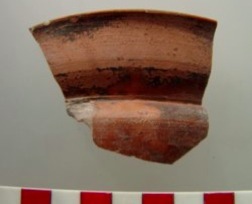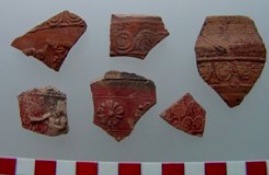




KELAINAI - APAMEIA KIBOTOS

Much more than any other material, pottery permits us to trace, stage by stage, the development of ancient sites of occupation. In consequence, the study of the appearance of pottery is absolutely necessary to obtain a complete outline of the history of a site.
Kelainai/Apamea is no exception to this rule. From its strategic site in the heart of Asia Minor and its historical importance, one could expect a priori to find a profile of pottery issues of Central Anatolia before the Hellenistic period with only a few importations or peripheral influences, after which the ceramic material loses, little by little, its autochthonous characteristics to become completely Hellenised. The two chronological extremities of the occupation of the site, prehistoric and Ottoman, could also be foreseen.
Consequently, we undertook a detailed work of analysis of the ceramic material collected in the course of the first two survey campaigns (2008-2009). This work was made difficult not only because of the poor state of conservation of the shards, usually collected on the surface, but also by the necessity to put in order the classification of a huge ensemble, principally coming from provincial workshops so far as the Iron Age is concerned.
After cleaning, the majority of the shards were placed in their categories, photographed, and assigned an inventory number. The most representative pieces were drawn. This first division permitted us to proceed with a statistical analysis of the density of pottery in the zones under study. After two campaigns, a preliminary classification was put in place. This already offers a complete outline of the range of pottery found at Kelainai/Apamea and of the specific problems which they raise. The whole of the material collected is today stored in the depot of the excavation-house at Dinar.
Within the many categories of pottery catalogued and destined to be published in an exhaustive monograph, certain ones have already benefitted from special attention, involving specific studies, including laboratory analysis, to wit:
- Iron Age material: composed of many important groups of painted pottery from central Anatolia: «Bichrom Ware» ; «Black on Red» ; and Orientalising pottery. Pertaining more or less to the end of the period of Phrygian and/or Lydian production, this material reveals the complex problems of typology, chronology, and provenance.
- «Achaemenid bowls» : many fragments belonging to this category were found at the site, whose emergence appears to be contemporary with the Persian presence. This material appears very similar to pottery of Sardis and must be the object of detailed analyses in order to determine whether there existed an exchange-relationship between the two sites.
- Hellenistic bowls with moulded reliefs: at Kelainai, this type of pottery is very heterogeneous in terms of paste, style, and technique. They clearly appear to come from different centres of production, both Eastern Greek (Ephesus?) and Lydian (Sardis?) A chemical analysis will be able to determine their provenance precisely.
- Culinary pottery with red glaze: almost all the zones studies have revealed the presence of a very typical variant of dish of Greek and Roman type. Composed of a reddish-purple clay and often sporting a brilliant sheen, as in the case of the contemporary ceramic Aydın, the production of this pottery could well have taken place in local, or at least regional, workshops. The majority of the material is thrown, although certain elements appear to have been added by hand. This category likewise includes storage pithoi. It is interesting to note a fragment of Hellenistic brasero bearing a relief-decoration consisting of a mask of Dionysos. The large range of forms will require us to undertake a thorough typological study; the chronology still remains uncertain, as does the location of their place of manufacture.
- Stamped tiles: an important batch of stamped tiles has been found at the site. The majority of the stamps are circular, though some were quadrangular. Certain ones among them bear complete monograms, of which two display an elaborate palmette. This material, closely related to products known from Pergamon, appears to belong to the Hellenistic period and to have been produced by a single workshop, local or not, whose location will not be able to determined with precision in the absence of specific chemical analyses.
It is clear that the majority of the material collected at the site presents serious problems of provenance which cannot be resolved without putting in place a systematic program of archeometric studies which will permit us to determine the chemical structure of local products of Kelainai/Apamea and to identify the provenance of imported material.
in charge of the pottery
P. DUPONT - V. LUNGU


Achaemenid bowl


Anatolian ceramic “Black on Red”

Bronze Age pottery

Bowls in relief of the Hellenistic period
updated: september 2nd, 2010


